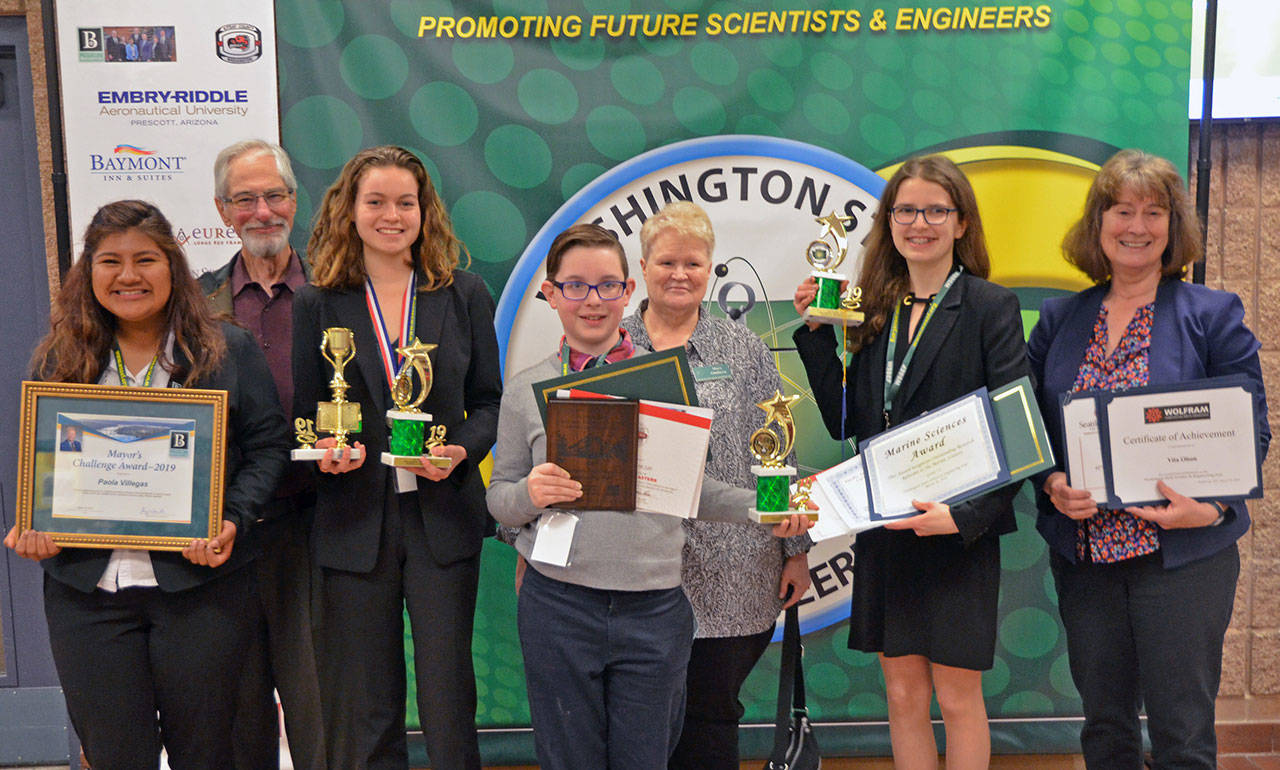Sequim Science Fair Club students competed against more than 500 students from across the state in the 62nd-annual Washington State Science and Engineering Fair (WSSEF), held March 30-31 in Bremerton.
Four Sequim students entered projects — some of whom have been working on their projects since this time last year — and brought home three first-place awards and one second-place award in their judging categories, along with a number of special awards.
SSEF offered more than $1,800,000 in scholarships, prizes, awards and one of two invitations to compete in the Intel International Science and Engineering Fair — the largest international pre-college science competition in the world to be held in Phoenix, Ariz., in May.
Vita Olson, a junior at Sequim High School and president of the Sequim Science Fair Club, was awarded one of the two ISEF invitations for her project, “A Survey of Lake Crescent for Endemic Salmonid Spawning Sites using eDNA.”
Olson sampled water from 15 locations around Lake Crescent during the spawning season. Sites included known spawning locations and potential spawning sites. Samples of water were collected and processed using a filtration system to collect any DNA present. Salmonid eDNA extraction was done using a modified protocol with a commercial DNA extraction kit. The location and protection of all spawning sites is important to the future conservation of these endemic salmonids.
Olson’s project earned several awards, including: WSSEF First Place in Animal Sciences Award (ribbon and trophy); USDA Forest Service’s Pacific Northwest Research Stations (certificate and plaque); Animal Sciences Research (certificate and cash award); Pacific Science Center (certificate, IMAX and exhibit passes); Wolfram Research, Inc. Mathematica Software, Ohio Wesleyan University, $20,000, renewable for four years; Washington State University College of Arts and Sciences, $3,000, renewable for four years, and Seattle Pacific University, $2,000, renewable for four years.
Paola Villegas, a sophomore from Sequim High School, was awarded second place in the Environmental Engineering category and special recognition from the City of Bremerton for completing the 2019 Mayor’s Challenge. The goal with her project, “Drone Identification of Scotch Broom,” was to visually locate the invasive plant, Scotch broom, using a remote controlled airship she designed and constructed from parts that the Science Fair Club procured.
Villegas’ airship contained a gondola and rudder, while the gondola contained the electric power plant — including two ducted fans for forward thrust, assent/descent. A propeller on stern steered the airship like an outboard motor. The gondola also had a video camera that recorded and transmitted real time images of the ground to the operator. Since Scotch broom was not in bloom, she simulated its color with yellow paper on the ground, then analyzed the images clipped out of the recorded video to quantify the amount of yellow in the image.
Her project earned Villegas other honors, including: Graphic Design Award (certificate and cash); Sights of Flight Award (Museum of Flight passes) and Adventures in Science (hotel accommodations).
Karlie Viada, an eighth-grade student from Sequim Middle School, was awarded first place in her grade level. Her project was titled “Evaluation of Local Aquatic Plants for Phytoremediation of Metals.”
Viada inquired: Do native aquatic plants from Western Washington have the ability to remove contaminant metals from water? She tested three plants — duckweed, hornwort and watercress — with copper and zinc contaminants added. Results indicated that the plants removed 63 to 71 percent of the copper that was added and 86 to 90 percent of zinc. The watercress and hornwort were slightly better at removing contaminants than duckweed. Her tests indicated that three times more copper was stored in roots/stems than in leaves. Results indicate all three of the evaluated aquatic plants would be effective at metal contaminant removal.
Viada’s project also earned other awards: Environmental Science Research award (certificate and cash award); Marine Sciences Outstanding Research (certificate and cash) and a Broadcom MASTERS honor, that comes with an opportunity to compete nationally.
Brody Andersen, a seventh-grader from Sequim Middle School, was awarded first place in his grade level for his project titled “Removal of Microparticles from Freshwater Using a Biofilter.” Andersen used spirogyra, a type of algae, with a filamentous quality that should be able to capture microparticles as a biofilter. He used a clear glass tank on a magnetic stirrer to keep microbeads suspended in water. He placed a laser on one side of the tank and on the other side a light meter to measure the strength of the light from the laser beam.
Andersen’s efforts earned him other awards, including: a USDA Forest Service’s Pacific Northwest Research Stations plaque; Plant Sciences Achievement Award (certificate and cash), and the Broadcom MASTERS honor, with an opportunity to compete nationally.



